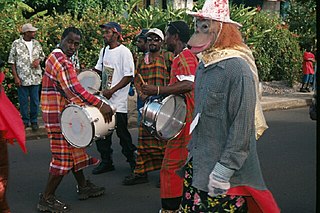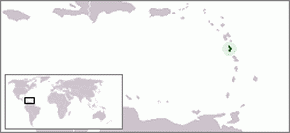The first written records in the history of Dominica began in November 1493, when Christopher Columbus spotted the island. Prior to European contact, Dominica was inhabited by the Arawak. Dominica was a French colony from 1715 until the end of the Seven Years' War in 1763, and then became a British colony from 1763 to 1978. It became an independent nation in 1978.

Castries is the capital and largest city of Saint Lucia, an island country in the Caribbean. The urban area had the population of approximately 20,000, while the eponymous district had a population of 70,000 on 22 May 2013. The city stretches over an area of 80 km2 (31 sq mi).
Roseau is the capital and largest city of Dominica, with a population of 14,725 as of 2011. It is a small and compact urban settlement, in the Saint George parish and surrounded by the Caribbean Sea, the Roseau River and Morne Bruce. Built on the site of the ancient Island Carib village of Sairi, it is the oldest and most important urban settlement on the island of Dominica.

The music of Dominica includes a variety of genres including all the popular genres of the world. Popular music is widespread, with a number of native Dominican performers gaining national fame in imported genres such as calypso, reggae, soca, kompa, zouk and rock and roll. Dominica's own popular music industry has created a form called bouyon, which combines elements from several styles and has achieved a wide fanbase in Dominica. Groups include WCK, Native musicians in various forms, such as reggae, kadans (Ophelia Marie, and calypso, have also become stars at home and abroad.

The Antilles is an archipelago bordered by the Caribbean Sea to the south and west, the Gulf of Mexico to the northwest, and the Atlantic Ocean to the north and east.

The term French West Indies or French Antilles refers to the parts of France located in the Antilles islands of the Caribbean:

The Dominica national football team is the national team of Dominica and is controlled by the Dominica Football Association. They are a member of CONCACAF.

Antillean Creole is a French-based creole that is primarily spoken in the Lesser Antilles. Its grammar and vocabulary include elements of Carib, English, and African languages.

The culture of Dominica is formed by the inhabitants of the Commonwealth of Dominica. Dominica is home to a wide range of people. Although it was historically occupied by several native tribes, the Taíno and Island Caribs (Kalinago) tribes remained by the time European settlers reached the island. "Massacre" is a name of a river dedicated to the murders of the native villagers by French and British settlers, because the river ran red with blood for days. Each claimed the island and imported slaves from Africa. The remaining Caribs now live on a 3,700-acre (15 km2) Carib Territory on the east coast of the island. They elect their own chief.
Cadence-lypso is a fusion of cadence rampa from Haiti and calypso from Trinidad and Tobago that has also spread to other English speaking countries of the Caribbean. Originated in the 1970s by the Dominican band Exile One on the island of Guadeloupe, it spread and became popular in the dance clubs around the Creole world and Africa as well as the French Antilles.
Exile One is a cadence musical group founded by Gordon Henderson in the 1970s with musicians invited over from Dominica, to be based in Guadeloupe. The band was influential in the development of Caribbean music. It became famous throughout the Caribbean, Europe, Africa and the Indian Ocean. Exile One opened the way for numerous Cadence-Lypso artists as well as for Zouk.

As an overseas départment of France, Martinique's culture is French and Caribbean. Its former capital, Saint-Pierre, was often referred to as the Paris of the Lesser Antilles. The official language is French, although many Martinicans speak a Creole patois. Based in French, Martinique's Creole also incorporates elements of English, Spanish, Portuguese, and African languages. Originally passed down through oral storytelling traditions, it continues to be used more often in speech than in writing.

Dominica, officially the Commonwealth of Dominica, is an island country in the Caribbean. The capital, Roseau, is located on the western side of the island. It is geographically situated as part of the Windward Islands chain in the Lesser Antilles archipelago in the Caribbean Sea. Dominica's closest neighbours are two constituent territories of the European Union, the overseas departments of France, Guadeloupe to the northwest and Martinique to the south-southeast. Dominica comprises a land area of 750 km2 (290 sq mi), and the highest point is Morne Diablotins, at 1,447 m (4,747 ft) in elevation. The population was 71,293 at the 2011 census.
The 1997 Caribbean Cup was the ninth edition of the Caribbean Cup hosted by Antigua and Barbuda and Saint Kitts and Nevis.

The following outline is provided as an overview of and topical guide to Dominica:

The following is an alphabetical list of topics related to the nation of Dominica.

This is a timeline of the territorial evolution of the Caribbean and nearby areas of North, Central, and South America, listing each change to the internal and external borders of the various countries that make up the region.

The languages of the Caribbean reflect the region's diverse history and culture. There are six official languages spoken in the Caribbean:
Dominican Creole French is a French-based creole, which is a widely spoken language in Dominica. It can be considered a distinct dialect of Antillean Creole.

Dominica–Mexico relations are the diplomatic relations between the Commonwealth of Dominica and the United Mexican States. Both nations are members of the Association of Caribbean States, Organization of American States and the United Nations.












